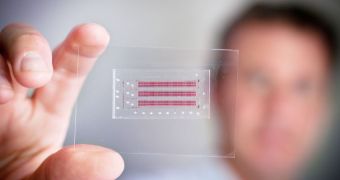University of British Columbia experts announce the development of an advanced microfluidic device, a lab-on-a-chip that could greatly improve the way genetic analysis are done today. The instrument could make the assessments cheaper, faster, and extremely sensitive.
The silicone chip the UBC group developed allows individual cells to fall into place all on their own. It is about the size of a 9-volt battery, and can holds about 300 individual cells at the same. The instrument contains a variety of tubes and valves, which are all very small.
Cells are poured into a fluid, which is then routed through channels, where they are analyzed. RNA is extracted from these cells, and then replicated. Experts can harvest it, and analyze its characteristics at a later date, if they choose to.
UBC experts say that this device could enable the creation of highly-detailed tests for diagnosing cancer and other conditions, in patients who are only beginning to develop these diseases. Earlier diagnosis could save lives and money.
Current genetic analysis technologies are “like trying to trying to understand what makes a strawberry different from a raspberry by studying a blended fruit smoothie,” researcher Carl Hansen explains.
The expert holds an appointment as an assistant professor in the UBC Deptartment of Physics and Astronomy, and also at the Center for High-Throughput Biology at the university. He was also the leader of the group that developed the new microfluidic device.
“Single-cell genetic analysis is vital in a host of areas, including stem cell research and advanced cancer biology and diagnostics. But until now, it has been too costly to become widespread in research, and especially for use in health care,” the investigator says.
“This technology, and other approaches like it, could radically change the way we do both basic and applied biomedical research, and would make single-cell analysis a more plausible option for treating patients – allowing clinicians to distinguish various cancers from one another and tailor their treatments accordingly,” he adds.
Details of the new device appear in the latest issue of the esteemed journal Proceedings of the National Academy of Sciences (PNAS). Scientists from the BC Cancer Agency and the Center for Translational and Applied Genomics were also a part of the effort.
The Genome BC, Genome Canada, Western Economic Diversification Canada, the Canadian Institutes of Health Research, the Terry Fox Foundation, and the Natural Sciences and Engineering Research Council funded this investigation.

 14 DAY TRIAL //
14 DAY TRIAL //